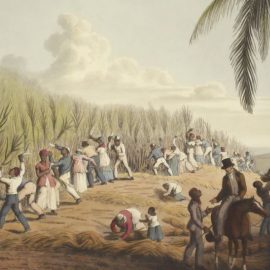
This is a free excerpt from one of Shortform’s Articles. We give you all the important information you need to know about current events and more.
Don't miss out on the whole story. Sign up for a free trial here .
What’s causing the Colorado River water shortage? What impact will it have on the river itself, water users, and the wider economy?
Reservoirs throughout the Colorado River drainage have become critically depleted because current water use agreements divert more irrigation water to farmers than the river can provide. Reduced availability of irrigation water could potentially diminish the nation’s food supply and drive up prices.
Keep reading to learn more about the cause and impact of the Colorado River water shortage.
The Colorado River Water Shortage Explained
The “megadrought” in the western United States is forcing tough decisions about how to allocate the water of the Colorado River, which is a critical source of irrigation for farms in several states, as well as Mexico. In this article, we’ll break down the cause and impact of the Colorado River water shortage, including how it could affect our food supply.
Problem: The Western Megadrought
The Colorado River water shortage is being driven by the megadrought in the western United States. A megadrought is just a drought on a larger scale: a period of less-than-normal rainfall or water availability that affects a large area and lasts for decades. There may be a few years of normal or even above-average rainfall within a megadrought, but the megadrought isn’t considered over until there’s been enough rain to bring the cumulative average back up to normal.
Most of the western United States has been in a megadrought since the 1990s or early 2000s. As of 2021, scientists concluded the current megadrought is worse than the Dustbowl of the 1930s. In fact, it’s the worst megadrought to hit the western U.S. in over a millennium, based on studies of ancient trees and the weather patterns reflected by their growth rings.
Impact on the Colorado River
Because of the megadrought, the demand for irrigation water in the Colorado River watershed now exceeds the supply, leading to the shortage. The average annual flow of the Colorado River dropped from about 17.5 million acre-feet in the early 1900s to about 13.5 million acre-feet around 2020. Meanwhile, water use from the river has increased steadily from less than 7 million acre-feet per year in the early 1900s to about 15 million acre-feet in the early 2000s.
Impact on Water Users and the Economy
Water from the Colorado River and its tributaries is widely used for agricultural irrigation in Wyoming, Utah, New Mexico, Colorado, Arizona, California, Nevada, and Mexico. As the watershed dries up, the shortage of irrigation water will devastate agriculture. Winter vegetable production is expected to be hit the hardest, as farms that rely on water from the Colorado River produce as much as 95% of the broccoli, lettuce, spinach, and other vegetables that supply U.S. markets in the winter. Due to the Colorado River water shortage, experts predict major price increases as well as a supply crunch.
Proposed Changes to Colorado River Water Allocation
Last year, the U.S. Bureau of Reclamation (which operates the system of dams and diversions on the Colorado River) called on the states that use the water to propose cuts to water allocations that would bring them in line with the current water supply. But the states couldn’t reach a consensus by the January 31 deadline.
Instead, six of the seven states agreed to a plan that would reduce total water allocations by about 1.5 million acre-feet per year. California rejected this plan and proposed a different one that only cuts about 1 million acre-feet total, and it proportions more of the cuts to Arizona instead of California.
California’s rationale is that its water rights are older than those in the other states. In irrigation law, when there isn’t enough water to deliver it to everyone who has a water right, the people with the oldest water rights get their water first, and the newcomers bear the brunt of the shortage.
What’s Next
As the affected states continue to debate how to handle the Colorado River water shortage, it’s up to the federal government to decide how much water to release from the reservoirs. The Bureau of Reclamation is expected to announce its plans later this month, and it will probably take both the proposed plans into consideration.
But neither proposed plan reduces water allocations as much as the government requested, and California is threatening a lawsuit if the federal government tries to cut more of its water than the California plan suggests.

Want to fast-track your learning? With Shortform, you’ll gain insights you won't find anywhere else .
Here's what you’ll get when you sign up for Shortform :
- Complicated ideas explained in simple and concise ways
- Smart analysis that connects what you’re reading to other key concepts
- Writing with zero fluff because we know how important your time is






